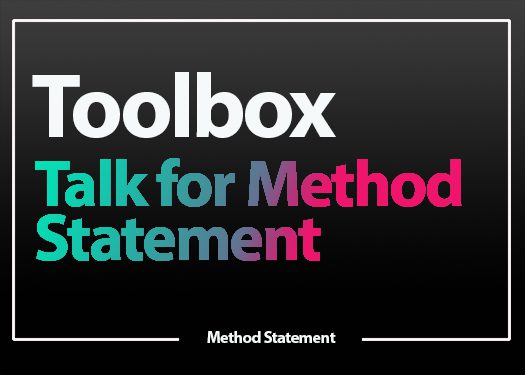Table of Contents
What is a Toolbox Talk?
A Toolbox Talk is a casual conversation held among employees of a specific department, with the aim of highlighting a particular safety concern.
The discussion usually takes place on-site or in a work setting and serves as a platform for workers to exchange knowledge, share experiences, and identify potential hazards. These talks are an integral part of any safety program and help promote a proactive approach toward workplace safety.
During a toolbox talk, team members can discuss various topics related to their job and identify any potential risks or hazards that may arise. The conversation may revolve around best practices for using equipment, following safety procedures, or identifying and reporting potential safety concerns.
By engaging in these discussions, employees can increase their awareness of safety practices and learn how to avoid accidents and injuries in the workplace.

Furthermore, toolbox talks help to promote a culture of safety within the workplace. When employees are actively engaged in safety discussions, they feel empowered to take an active role in maintaining a safe work environment. As a result, they are more likely to follow safety protocols and procedures, reducing the likelihood of workplace accidents and injuries.
The toolbox talks are an essential aspect of any safety program. They provide an informal and interactive platform for employees to discuss safety concerns, share their experiences and knowledge, and develop a safety-conscious mindset.
By encouraging participation and engagement, organizations can foster a culture of safety and improve their overall safety performance.
Method statements are important documents that record specific hazards and risks associated with a hazardous or non-routine task. They play a crucial role in ensuring the safety of workers and contractors by outlining necessary precautions and methods to manage risks.
Why Conduct a Method Statement Toolbox Talk?
Purpose of a Method Statement
The purpose of a method statement is to provide job-specific inputs, carry out work safely, identify potential hazards, outline necessary precautions, and describe methods and controls used to manage risks.
A toolbox talk on Method Statement will help to ensure that everyone involved in a task understands these aspects and is prepared to work safely.
A Method Statement should provide specific inputs related to the task at hand, ensuring that work is carried out safely. It should identify potential hazards and outline necessary precautions and controls to mitigate risks. The statement should also describe the methods used to manage risks and ensure safety.
Who Is Responsible for Writing a Method Statement?
Generally, the main contractor, site supervisor, foreman, or team carrying out the work is responsible for writing a Method Statement. They should ensure that all workers’ inputs are incorporated into it, and workers have access to a copy.
It is best practice to write a method statement for high-risk work, non-routine or complex work, work involving sub-contractors or others on-site, and work involving electricity.
Contents of a Method Statement
A Method Statement should be sequential, easy to understand, tailored, consultative, and complete. It should contain basic information such as the company or contractor doing the work, the location, expected dates and times, a brief summary of work and sequential steps, materials and/or plant that will be operated, tools needed, significant hazards identified, details of hazardous substances, health and safety contacts, and emergency response procedures. For more complex work, further information may be required.
Key Takeaways
Method Statements should be included as part of a safe system of work, be job-specific, and be easily understood by everyone involved in the work. They might also be known as a JSA (Job Safety Analysis), task analysis, or Safe Work Method Statement.
A Toolbox Talk is a discussion among workers to highlight safety concerns and promote a proactive approach to workplace safety.
Method Statements are important documents that outline necessary precautions and methods to manage risks associated with hazardous or non-routine tasks. A method statement toolbox talk helps ensure that everyone involved in a task understands these aspects and is prepared to work safely.
Understanding the importance of a method statement is crucial in ensuring a safe working environment. By following the guidelines outlined in this article, workers can be better equipped to identify and mitigate risks associated with hazardous or non-routine tasks.
FAQs
What is a toolbox talk on the construction site and why is it important?
A toolbox talk is a short safety meeting that takes place on a construction site before work begins. It is important because it helps to promote safety awareness, identify potential hazards, and review safety procedures.
What are some common topics covered during a toolbox talk on a construction site?
Some common topics covered during a toolbox talk on a construction site include fall protection, electrical safety, PPE (Personal Protective Equipment), hazard communication, and equipment safety.
How often should toolbox talks be conducted on a construction site?
Toolbox talks should be conducted regularly, at least once a week, to ensure that workers are constantly reminded of safety procedures and potential hazards.
What are some best practices for delivering an effective toolbox talk in the construction industry?
To deliver an effective toolbox talk, it is important to use language that is easy to understand, engage workers in the discussion, and use visual aids when appropriate. The speaker should also be knowledgeable about the topic and prepared to answer any questions.
How can technology be used to enhance toolbox talks and improve safety in the construction industry?
Technology can be used to enhance toolbox talks by providing interactive training modules, virtual reality simulations, and real-time hazard alerts. This can improve worker engagement and retention, and help to identify potential safety issues before they become hazards.
tag: # toolbox talk, method statement
